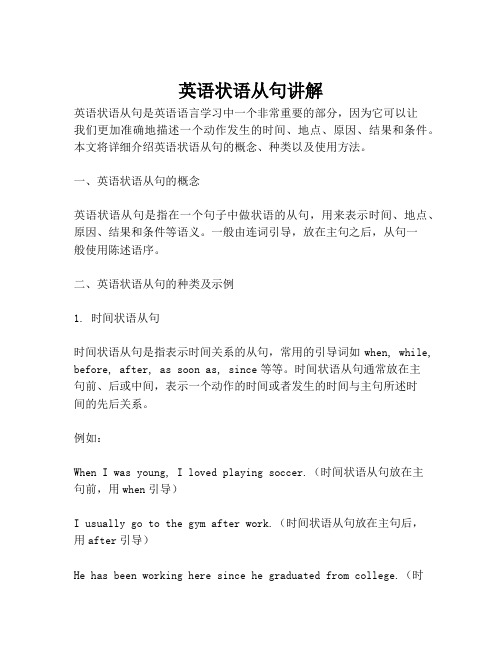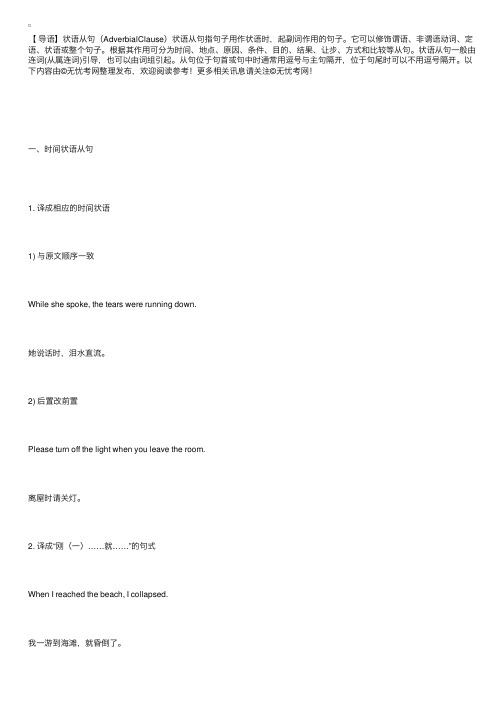状语从句讲解
- 格式:doc
- 大小:70.00 KB
- 文档页数:5

状语从句的讲解就是用一句话作状语分为:时间,地点,方式,原因,结果,条件,让步,目的,比较一、时间状语从句第一次见到你一见到你我就喜欢上了你直到见到你五岁时见到你When, as, while, before, after, since, till/until, as soon as no sooner…than…scarcely…when…hardly…when… the minute the second the instant the moment by the time 截止 immediately instantly directlyeach time every time next time the first time on doing sthwhenwhile 当…时as1。
when 1)当…时/ 延续性动词短暂性动词都可用2)这时/3)届时、到时I was watching TV when my cellphone suddenly rang这时When I was five years old I could speak five languagesThe wet weather will continue tommorow when a cold front is expected to arrive届时到时注意:时间状语从句中动作发生有前后时先发生的用过去完成时When my mother came back I had already gone to bed.2。
while 1)从句动词延续性2)同时发生3)对比的意味“然而”4)趁着He taught himself while he worked in a bank 延续性动词当他在银行上班时While we were working they were having a rest.对比While they were having a discussion , they got very confused。

状语从句的详细讲解状语从句(Adverbial Clause)状语从句指句子用作状语时,起副词作用的句子。
它可以修饰谓语、非谓语动词、定语、状语或整个句子。
根据其作用可分为时间、地点、原因、条件、目的、结果、让步、方式和比较等从句。
状语从句一般由连词(从属连词)引导,也可以由词组引起。
从句位于句首或句中时通常用逗号与主句隔开,位于句尾时可以不用逗号隔开。
种类1.时间状语从句2.地点状语从句3.原因状语从句4.条件状语从句5.目的状语从句6.让步状语从句7.比较状语从句8.方式状语从句9.结果状语从句状语从句详细讲解:时间状语从句常用引导词:when, as, while, as soon as, before, after, since , till, until特殊引导词:the minute, the moment, the second, every time, the day,the instant, immediately , directly, no sooner … than, hardly …when, scarcely … when重点:when“当……时”,引导时间状语从句时,从句用于表示主句动作发生的特定时间。
如:The days get longer when spring comes. = When spring comes, the days get longer. 春天到来时,白天变得更长了。
二、before“在……之前”,引导时间状语从句时,表示主句动作发生在从句动作之前。
如:Close the door before you leave the room.离开房间前关上门。
三、after“在……之后”,引导时间状语从句时,表示主句的动作发生在从句的动作之后。
如:I went to school after I finished my breakfast.吃完早饭后我就去上学了。

英语状语从句讲解英语状语从句是英语语言学习中一个非常重要的部分,因为它可以让我们更加准确地描述一个动作发生的时间、地点、原因、结果和条件。
本文将详细介绍英语状语从句的概念、种类以及使用方法。
一、英语状语从句的概念英语状语从句是指在一个句子中做状语的从句,用来表示时间、地点、原因、结果和条件等语义。
一般由连词引导,放在主句之后,从句一般使用陈述语序。
二、英语状语从句的种类及示例1. 时间状语从句时间状语从句是指表示时间关系的从句,常用的引导词如when, while, before, after, as soon as, since等等。
时间状语从句通常放在主句前、后或中间,表示一个动作的时间或者发生的时间与主句所述时间的先后关系。
例如:When I was young, I loved playing soccer.(时间状语从句放在主句前,用when引导)I usually go to the gym after work.(时间状语从句放在主句后,用after引导)He has been working here since he graduated from college.(时间状语从句放在主句后,用since引导)2. 地点状语从句地点状语从句表示一个动作所发生的地点,通常由where、wherever 引导。
例如:Wherever you go, I will follow you. (地点状语从句中,wherever 引导)I will go wherever the wind takes me.(地点状语从句中,where 引导)3. 原因状语从句原因状语从句表示主句的动作发生的原因,通常由because、since、as等引导。
例如:Since it was raining outside, I chose to stay at home.(原因状语从句中,since 引导)Because she was sick, she couldn't go to the party.(原因状语从句中,because 引导)4. 结果状语从句结果状语从句用于表示主句所述的情况或动作的结果,通常由so、such...that等引导。

状语从句一、状语从句定义在复合句中,由一个从句充当状语,该从句被称为状语从句。
它可以用来修饰谓语(包括非谓语动词)、定语、状语或整个句子。
状语从句通常由一个连词引导,也可以由一个起连词作用的词组引导。
二、状语从句的分类(一)时间状语从句在时间状语从句中,要注意时态一致问题。
一般情况下主句将来时的时候,从句要用一般现在时表示将来。
可以引导时间状语从句的连词很多,根据意义和主从句之间的关系,又可分为:1)表同时性,即主从句谓语动作同时发生或几乎同时发生。
其连词有:as(当…时候)、while、when、as soon as、once(一旦…)等。
例如:Strike while the iron is hot.I do every single bit of housework, while my husband Bob just does the dishes now and then.As/When I came home, I met one of my old friends.I will ring you up as soon as he comes.Once you see her son, you will never forget him.高考例题:1. How can you expect to learn anything ______ you never listen?A. in caseB. even ifC. unlessD. when2. He transplanted the little tree to the garden ______ it was the best time for it.A. whereB. whenC. thatD. until3. Don’t be afraid of asking for help ______ it is needed.A. unlessB. sinceC. althoughD. when2)表先时或后时,即主句的谓语动作发生在从句之前或之后,主要连词有:before、after、when(=after)等。

状语从句讲解状语从句由从属连词(subordinating conjunctions)引导。
注意状语从句与主句之间的逻辑关系,选择正确的连词;有些连词能引导多种状语从句。
一、时间状语从句引导时间状语从句的从属连词主要有:after,as,before,once, since,till,until,when,whenever,while,as soon as;另外有些词如:immediately(立刻),directly(直接的),instantly(立即地)用于as soon as 意义时,有些名词词组如the moment(片刻),the instant(立即的),the minute,the day,the year,every time,next time,each time 等也用来引导时间状语从句:The mother didn't go to bed until her little daughter returned home last night. 昨晚母亲等到她的小女儿回家才睡觉。
I'll explain it to you immediately I've finished reading the letter. 我读完信立刻给你解释。
You see the lightning __________it happens,but you hear the thunder later.A)the instant(立即) B)for an instantC)on the instant(马上) D)in an instant(马上)闪电一发生,你立刻就能看到它,但雷声,你迟一点才能听到它。
(B4,1997.1-38,A对。
)No sooner ... than 和hardly/scarcely/barely ... when 也用来引导状语从句,意思是“一……就……”;如果将no sooner,hardly, scarcely,barely放在句首,就用倒装结构。

【导语】状语从句(AdverbialClause)状语从句指句⼦⽤作状语时,起副词作⽤的句⼦。
它可以修饰谓语、⾮谓语动词、定语、状语或整个句⼦。
根据其作⽤可分为时间、地点、原因、条件、⽬的、结果、让步、⽅式和⽐较等从句。
状语从句⼀般由连词(从属连词)引导,也可以由词组引起。
从句位于句⾸或句中时通常⽤逗号与主句隔开,位于句尾时可以不⽤逗号隔开。
以下内容由©⽆忧考⽹整理发布,欢迎阅读参考!更多相关讯息请关注©⽆忧考⽹!⼀、时间状语从句1. 译成相应的时间状语1) 与原⽂顺序⼀致While she spoke, the tears were running down.她说话时,泪⽔直流。
2) 后置改前置Please turn off the light when you leave the room.离屋时请关灯。
2. 译成“刚(⼀)……就……”的句式When I reached the beach, I collapsed.我⼀游到海滩,就昏倒了。
3. 译成并列的分句1) 译⽂前置They set him free when his ransom had not yet been paid.他还没有交赎⾦,他们就把他释放了。
2) 后置不变I was about to speak when Mr. Smith cut in.我正想讲,史密斯先⽣就插嘴了。
⼆、原因状语从句1. 译成表“因”的分句1) “因”在“果”之前The crops failed because the season was dry.因为⽓候⼲旱,作物歉收。
2) “果”在“因”之前She could get away with anything, because she looked such a baby.她能渡过任何风险,因为她看上去简直还像娃娃模样。
2. 译成因果偏正复句中的主句Pure iron is not used in industry because it is too soft.纯铁太软,所以不⽤在⼯业上。
状语从句引导状语从句的从属连词:(包括:时间,地点,原因,条件,让步,结果,目的,方式,比较等)1时间状语从句:A. *when: 从句可用1)非延续性动词,表点时间=at the time when…2)延续性动词,表段时间,此时可与while / as互换。
注:a)从句中的动作既可与主句动作同时发生b)也可在主句动作之前或之后发生。
后者不可与while/as 两者换用。
.When I got home, he was having supper. b).When(=Before) I got to the party , some guests had left.When(=After)he finished his work, he took a short rest.3)也可做并列连词,“这时”be about to do/ be going to do/ be doing… when…had hardly/just/scarcely/not done…when…*while:1)“在…期间”;从句只能用延续性动词,表段时间=during the time when...2)当“趁着”讲。
3) “尽管” = althougheg.____ I admit that the problems are difficult, I don’t agree that they can’t be solved.A. WhileB. WhenC. AsD. Because3)也可做并列连词,表对比关系,“而”。
*as: 1)“随着”,指动作的进程(with也有“随着”之意,但是介词,只跟短语。
)“一边```一边```”,强调主从句谓动的同时发生。
1._______________he was in Beijing, he made a lot of friends.--->When /While in Beijing,…2._______________he was studying in Beijing, he made a lot of friends.--->When /While studying in Beijing,…--->During the time when he was( studying) in Beijing,…3.______he arrived in Beijing, he received a warm welcome.--->At the time(when )he arrived in Beijing,…/At the time of his arrival, …4. _____ time goes on, the situation is getting worse and worse.5. The atmosphere gets thinner and thinner______ the height increases. (从句)--->with the increase of the height. (短语)6. The students took notes ______they listened./ He hurried home, looking behind _____ he went.7. Strike __________the iron is white-hot. 趁热打铁。
状语从句讲解及习题附答案(一)状语从句概述定义状语从句用作状语,是起副词作用的句子。
位置状语从句可以放在主句之前,也可以放在主句之后,时间、条件、原因和让步状语从句放在句首时需要用逗号和主句隔开。
分类根据其作用可以分为时间、地点、原因、条件、目的、让步、方式和比较等状语从句。
作用它可以修饰谓语、非谓语动词、定语、状语和整个句子。
(二)状语从句详解1. 时间状语从句引导词用法示例when 意为“当…的时候”。
When引导从句的谓语动词可以是延续性动词,也可以是瞬间动词。
并且when有时表示“就在那时”A liar is not believed when he speaks the truth.说谎者讲真话时也没有人相信。
When he arrives, I’ll call you. When you laugh and smile, your body relaxes.while 意为“在…的时候,在…的同时”。
While引导从句的谓语动词必须是延续性的,发生时间较长,并强调主句和从句的动作同时发生(或者相对应)。
While有时还可以表示对比。
While I was standing at the window, I saw several boys running along the street.While John was watching TV, his wife was cooking.as 意为“一边…一边…”。
As引导的动作是延续性的,发生时间较短,一般用于主句和从句动作同时发生;as也可以强调一前一后。
The writer was angry as he was travelling on a train to London because someone had invaded his “space”.He smiled as he stood up.after 意为“在…之后”。
状语从句讲解一、概念:状语从句(Adverbial Clause)----指用以修饰谓语、非谓语动词、定语、状语或整个句子的句子,当副词使用。
状语从句一般由从属连词引导,也可以由词组引起。
从句位于句首或句中时通常用逗号与主句隔开,位于句尾时可以不用逗号。
二、分类1.时间状语从句2.地点状语从句3.原因状语从句4.条件状语从句5.目的状语从句6.让步状语从句7.比较状语从句8.方式状语从句9.结果状语从句(一)时间状语从句常用引导词:when, as, while, as soon as, before, after, since , till, until特殊引导词:the minute, the moment, the second, every time, the day,the instan t, immediately , directly, no sooner … than, hardly …when, scarcely … when1.while在...期间:He visited a lot of places while he was traveling.他在旅行期间参观了许多地方。
2.as在...的同时;一边...一边...:We always sing as we walk.我们总是一边走一边唱。
3.after在...之后:He left the classroom after he had finished his homework.他做完作业之后就离开教室。
4.before 在...之前:He had worked in a bank for a year before he came here.他来这里之前已经在一家银行里工作一年了。
5.as soon as 一…就…:We began to work as soon as we got there.我们一到那就开始工作。
高中英语状语从句讲解状语从句在句中作状语,修饰主句中的动词、形容词或副词等。
状语从句放在主句之前时,常用逗号分开:放在主句之后,一般不用逗号。
状语从句按其意文和作用可分为时间、条件、原因、让步、目的、结果、方式、比较、地点等九种。
1.时间状语从句时间状语从句常用连词有when,as,while,before,after,since,till(until),as soon as,hardly…when…,no sooner…than,the moment等。
时间状语从句一般不用将来时,因此,主句若为将来时,时间状语从句要用一般现在时。
如:I'll go on with the work when I come back tomorrow.⏹when, while与as的异同作为从属连词,三者的意思都是“当…时候”,在用法上有如下异同点。
1.在主句的谓语动词表示短暂动作,而从句说的是一段时间发生的动作时,三个连词都可以。
如:I met him as/when/while I was doing some shopping.2.从句动作发生的时间如果是某一点,而且主句动作同时或几乎同时发生时,不能用while,而只能用when或as。
如:I met him as/when I was getting off the bus.3.当从句动作发生在主句动作之前时,只能用when,如:I will ring you up when I return.4.主句用进行时态,从句动作发生的时间如果是某一点,只能用when。
如:My mother was cooking the supper when I got home.5.如果主句和从句的动作都在一段时间发生,可用as或while,只不过as强调主句和从句中的动作同时发生,而while强调主句的动作延续于while所指的整个时间。
As I put on my coat,something fell out of the pocket onto the floor.While he was in prison,Joe Hill continued to write songs to keep up the worker's fight.⏹when的从属连词用法when作为从属连词引导时间状语从句,既可放在主句之前,也可放在主句之后。
状语从句定义:在句中作状语的从句是状语从句,修饰主句中的动词、形容词或副词等。
状语从句由从属连词引导,从属连词在句中不充当句子成分,只起连接作用,状语从句放在句首时,要用逗号,放在句尾时不用。
状语从句主要用来修饰主句或主句的谓语。
一般可分为九大类,分别表示时间、地点、原因、目的、结果、条件、让步、比较和方式。
尽管种类较多,但由于状语从句与汉语结构和用法相似,所以理解和掌握它并不难。
状语从句的关键是要掌握引导不同状语从句的常用连接词和特殊的连接词即考点。
现分别列举如下:一、时间状语从句1.when, while和as的用法(1)when既可引导一个持续动作,也可引导一个短暂性动作.when强调主从句动作的发生有先后。
如:①When he got there, the classroom had been cleaned.他到的时候,教室已打扫过了。
(主句动作发生在从句动作之前)②He went to play football when he finished his homework.做完作业后他就去踢足球了。
(主句的动作发生在从句动作之后)when可作并列连词用,相当于just then,at the time,前一分句多用进行时、be about to 或be on the point of doing,表示“正在做..,就在这时发生了另外一件事”或“届时”。
如:①I was reading when he suddenly came in.②I was about to leave when the telephone rang.(2)while强调主句动作发生在从句动作所发生的时间段内,从句的动作必须是延续性动词。
如:①Strike iron while it’s still hot.②Will you please take care of my house while I was away?在这一情况下,从句的动作一定是延续性动词,如果是非延续动词,要用when。
如:①Will you please take care of my house when I went away?②当我进来的时侯,他在和别人说话。
While I came in, he was talking with others.When I came in, he was talking with others.(3)as引导一个持续性动作,强调主从句的动作同时发生,有“一边..一边..”的意思,也可说明两种正在发展或变化的情况,有“随着..”的意思。
如:①He sang as he walked.他边走边唱。
②As he gets older, he gets more open.随着年龄的增长,他越发开朗起来。
2.as soon as, the moment, the minute, the second, the instant, no sooner...than, hardly/scarcely...when...,immediately, directly, instantly的用法。
这些从属连词引导的从句都表示从句的动作一发生,主句的动作随即就发生,常译为“一……就……”,The moment she arrives,we can start.No sooner had we arrived at the station than the train left.The boy burst into tears immediately he saw his mother.3.till, until和not...until的用法(1)在肯定句中,主句谓语动词必须是延续性动词,意为“某动作一直延续到某点才停止”。
You may stay here till/until the rain stops.你得在这里呆到雨停。
(2)在否定句中,主句谓语动词必须是非延续性动词,从句为肯定式,意为“某动作直到某时间才开始”。
He won't go to bed till (until) she returns.直到她回来他才睡。
(3)not...until句型中的强调和倒装说法。
It was not until you told me that I had any idea of it. (强调句型)Not until you told me did I have any idea of it. (not until 置于句首,主句要倒装)Not until he came back did he find his house had been broken into.4.before和since的用法(1)连词before表示“还未……就……”,“不到……就……”,“……才……”,“趁还没来得及……”。
Before they reached the station, the train had gone.We hadn't run a mile before he felt tired.Please write it down before you forget it.(2)before的句型:It will be+时间段+before从句,表示“多久之后才……”。
It will be half a year before I come back.It won't be long before we meet again.(3)since的句型:It is/has been+时间段+since从句。
若从句谓语为非延续性动词,表示“自从……有多久”;若从句的谓语为延续性动词,表示“自从结束/完成……起有多久”。
It is three years since the war broke out.It is three years since he lived here.二.地点状语从句1.地点状语从句可用where, wherever, anywhere, everywhere等引导。
地点状语从句可用于主句之前或之后。
You are free to go wherever you like.Where there is a will, there is a way.有志者,事竟成。
Wherever there is smoke, there is a fire.无火不生烟(既无风不起浪)。
2.注意区分引导的定语从句与状语从句。
where引导的地点状语从句直接修饰动词,而在定语从句中where作为关系副词要跟在表示地点的先行词后面。
You'd better make a mark where you have any questions.(状语从句)You'd better make a mark at the place where you have any questions.(定语从句)三.原因状语从句1.引导原因状语从句的从属连词有:because, as, since, now that, seeing that, considering that等,每个连词的含义不尽相同。
(1)because用来回答why的提问,语气最强,一般放在主句之后;(2)since表示既然或已知的理由,稍加分析即可表明的原因,多放在句首;(3)as多用于口语,语气比because,since弱,表示的理由是明显的或被认为是已知的,是对主句的附带说明,重点在主句,可放在句首或句尾,放在句尾时,as可省略。
I can’t go,(as) I am busy.(4)considering that, seeing that, now that和since的意义相似,都有“鉴于某个事实”的意思,that可以省去。
As it is raining, we shall not go to the park.Now that/Since everybody is here, let's begin our meeting.既然大家都到了,我们就开始我们的会议。
My friends dislike me because I’m handsome and successful.Now that everybody has come, let’s begin our conference.四.目的状语从句引导目的状语从句的从属连词有:so that, in order that, for fear that,in case, lest等。
1.in order that与so that两个连词都意为“以便……,为了……”,引导的状语从句中需用情态动词;in order that 比so that正式,引导的状语从句可置于主句之前或之后,而so that引导的从句只能置于主句之后。
I'll speak slowly so that you can understand me.In order that we might see the sunrise, we started for the peak early.The boss asked the secretary to hurry up with the letters so that he could sign them.2.for fear that, in case与lest这些从属连词本身带有否定意义,意为“以免,以防”,相当于so that...not...或in order that...not...The boy hid himself behind the tree in case/for fear that his father should see him.Take your raincoat in case/lest it should rain.五.结果状语从句1.引导结果状语从句的从属连词有:so that, so...that...,such...that...。
其结构形式为:Mike is so honest a worker that we all believe him.=Mike is such an honest worker that we all believe him.He earned so little money that he couldn't support his family.He got up so early that he caught the first bus.It’s such a good chance that we must not miss it.区别so...that和such...that的用法名前such,形、副so,that从句跟在后;多多少少必用so,特别注意是little;“小”用such,“少”用so。